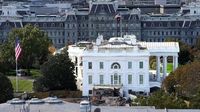On October 24, 2025, the White House’s East Wing—a fixture of American political life for over a century—was reduced to rubble, making way for a $300 million ballroom commissioned by President Donald Trump. The demolition, completed just days earlier, has ignited a national debate about the balance between historic preservation and presidential prerogative, with voices from late-night television to preservationist groups weighing in on what’s been lost—and what’s being built in its place.
Photos showing the devastation emerged Thursday, confirming that not only the East Wing, but also the East Colonnade and the storied White House Family Theater, had been swept away. According to The Hill, excavators began their work on October 20, and by the 23rd, the “Late Great East Wing,” as the White House website now describes it for Christmas tours, was gone. The staff who once worked there—including the First Lady’s team, the social secretary, and the calligrapher—have been relocated elsewhere in the executive mansion, CNN reported.
The Trump administration has defended the project as “a bold, necessary addition,” emphasizing that the ballroom is privately funded, with major corporate donors such as Comcast and Amazon footing the bill. In a statement issued Tuesday, the White House noted, “Presidents do change the buildings,” referencing the long tradition of executive renovations—from Nixon’s bowling alley to Obama’s transformation of the tennis court into a basketball court. Yet, the scale and symbolism of this demolition have struck a nerve well beyond the capital.
On the October 24 episode of Real Time with Bill Maher, the controversy took center stage. When panelist Michael Steele lamented “the destruction of a symbol of this government,” Maher responded with characteristic irreverence: “You’re talking about the White House? Oh, it’s a building, Mike. It’s a building.” Steele pushed back, sharing personal memories of the building’s significance growing up in D.C., but Maher insisted, “I can’t get this mad about everything, Mike, I just can’t.” He conceded, “He should have gotten the permits. But that’s how he does things. I agree. But it is just a building… that part of the building wasn’t always there.”
Yet for many, it’s not just about bricks and mortar. Panelist Kate Bedingfield argued that the demolition is emblematic of Trump’s “impulsive, reckless, driven by his own desire for self-aggrandizement” style of governing. “If this was the only thing he had done on that front, then I would give you, ‘it’s just a building,’” she said. “But it’s not. It’s part of a manner of governing that’s tearing at some of the institutional foundations in this country, and that’s scary.” Maher, ever the satirist, later joked in his ‘New Rules’ segment: “Now that President Trump is redecorating the White House, building a ballroom and hosting brunches at his new rose garden club… He has to start a new series called Queer Eye for the Authoritarian Guy.”
Preservationists and historians have been especially vocal. The East Wing’s history is long and layered, dating back to President Thomas Jefferson’s installation of colonnades in the early 1800s. According to the White House Historical Association, these architectural features “facilitated staff movement and added a refined architectural element to the White House.” The East Colonnade, which was also razed, had been rebuilt in 1902 during Theodore Roosevelt’s overhaul of the mansion, serving as a main entrance for social events.
The East Wing’s role evolved over the decades. In 1942, President Franklin D. Roosevelt expanded the wing to accommodate the White House’s growing staff and added the Presidential Emergency Operations Center, an underground bunker. The bunker has served as a secure haven during national crises, including the September 11, 2001 attacks and the George Floyd protests in 2020. The recent demolition means renovations to the bunker will now be overseen by the White House Military Office, CBS News reported.
First Ladies also left their mark. Eleanor Roosevelt established the formal office in the East Wing, and subsequent First Ladies—from Jacqueline Kennedy to Melania Trump—expanded its staff and influence. The wing became a hub for social planning and public engagement, as well as a symbol of the evolving role of presidential spouses in American civic life.
Perhaps the most poignant loss for many was the White House Family Theater. Born in 1942 when a cloakroom was converted into a screening room, the 42-seat cinema provided entertainment for presidents and their families for more than 80 years. Franklin D. Roosevelt watched World War II newsreels there, famously declaring in 1943, “Entertainment is always a national asset. Invaluable in time of peace, it is indispensable in wartime.” Before the theater’s creation, President Woodrow Wilson had already brought movies into the White House, projecting the controversial 1915 film “The Birth of a Nation” onto the walls of the East Room.
Over the years, the Family Theater became a cherished perk. Former President Bill Clinton once said, “The best perk out in the White House is not Air Force One or Camp David or anything else. It’s the wonderful movie theatre I get here, because people send me these movies all the time.” Its décor evolved—from green chairs and mustard curtains to its most recent all-red design. Presidents from Ronald Reagan to Barack Obama hosted screenings of everything from “E.T.: The Extra-Terrestrial” (which Steven Spielberg recalled showing to Reagan, Sandra Day O’Connor, and possibly Neil Armstrong) to “Men in Black 3.” The theater was also the site of lighter moments, such as when President Jimmy Carter’s policy of showing only “family friendly” films was upended by an accidental screening of the X-rated “Midnight Cowboy.”
The demolition has not come without public outcry. Preservationists pleaded with the National Capital Planning Commission and the National Park Service to slow down the process and allow for the legally required public review. Editorials have condemned the loss, and according to The Hill, more than half of Americans surveyed opposed the destruction. Critics argue that the speed and secrecy of the project mirror past controversies, such as when FDR’s wartime expansions were derided as wasteful and self-serving.
Supporters of the new ballroom, however, point to the tradition of presidents leaving their mark on the White House and the necessity of updating spaces to fit modern needs. The Trump administration has insisted that the ballroom will enhance the mansion’s capacity for official events and international diplomacy, and that the project’s private funding relieves taxpayers of the burden.
As the dust settles, the debate over the East Wing’s demolition is unlikely to fade soon. For some, it’s another chapter in the White House’s long history of adaptation. For others, it’s an irreplaceable loss—a symbol of a presidency willing to bulldoze not just walls, but traditions. The new ballroom may soon host glittering galas and state dinners, but the echoes of the East Wing’s storied past will linger just beneath the surface, a reminder that even in Washington, history is never truly safe from change.






